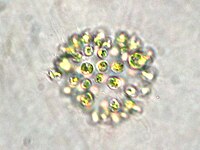
Variability in skeletal bulk densities of common hard corals in Southeast Asia
Sign Up to like & getrecommendations! Published in 2019 at "Coral Reefs"
DOI: 10.1007/s00338-019-01852-2
Abstract: Skeletal density, a measure of a coral’s investment in its structure and a known proxy for climate history, can potentially be used to enhance the precision of reef accretion models and benefit reef management strategies.… read more here.
Keywords: densities common; southeast asia; colony size; skeletal density ... See more keywords

Removal of Microcystis blooms using enhanced colony formation and buoyancy by controlling extracellular polysaccharides and cation concentrations
Sign Up to like & getrecommendations! Published in 2019 at "International Journal of Environmental Science and Technology"
DOI: 10.1007/s13762-019-02289-4
Abstract: This study attempted to promote the colony formation and enlarge the colony size of wild Microcystis strain by adjusting extracellular polysaccharides and cationic ion concentrations in culture medium, and then, using the enhanced floating velocity… read more here.
Keywords: microcystis; colony; colony size; colony formation ... See more keywords

Linking colony size with quantitative estimates of ecosystem services of African fruit bats
Sign Up to like & getrecommendations! Published in 2019 at "Current Biology"
DOI: 10.1016/j.cub.2019.02.033
Abstract: Animal-mediated seed dispersal is a pivotal component of functioning forest ecosystems all over the globe. Animals that disperse seeds away from their parental plants increase the seeds' chances of survival by releasing them from competition… read more here.
Keywords: colony size; linking colony; estimates ecosystem; size ... See more keywords

Colony formation in two Microcystis morphotypes: Effects of temperature and nutrient availability.
Sign Up to like & getrecommendations! Published in 2018 at "Harmful algae"
DOI: 10.1016/j.hal.2017.12.006
Abstract: The ability of Microcystis to form large colonies is a key trait that contributes to competition ability over other phytoplankton and facilitates the formation of surface scums in many freshwater systems. The effect of temperature… read more here.
Keywords: availability; colony; microcystis; colony size ... See more keywords

Morphospecies-dependent disaggregation of colonies of the cyanobacterium Microcystis under high turbulent mixing.
Sign Up to like & getrecommendations! Published in 2018 at "Water research"
DOI: 10.1016/j.watres.2018.05.017
Abstract: Preventing formation of large colonies and reducing colony size of the cyanobacterium Microcystis may lead to reductions in bloom formation. Here we investigated the effects of artificial mixing on morphology and disaggregation dynamics of Microcystis… read more here.
Keywords: turbulent mixing; disaggregation; cyanobacterium microcystis; colony size ... See more keywords

The role of oceanographic conditions and colony size in shaping the spatial structure of Pyrosoma atlanticum in the NW Mediterranean Sea
Sign Up to like & getrecommendations! Published in 2022 at "Journal of Plankton Research"
DOI: 10.1093/plankt/fbac056
Abstract: Abstract This study investigates the role of winter oceanographic conditions on the horizontal and vertical spatial structure of Pyrosoma atlanticum at different ontogenetic stages. Data were obtained on two oceanographic cruises (February 2017 and 2018)… read more here.
Keywords: spatial structure; colony size; oceanographic conditions; structure pyrosoma ... See more keywords

Using colony size to measure fitness in Saccharomyces cerevisiae
Sign Up to like & getrecommendations! Published in 2022 at "PLoS ONE"
DOI: 10.1101/2022.07.07.499129
Abstract: Competitive fitness assays in liquid culture have been a mainstay for characterizing experimental evolution of microbial populations. Growth of microbial strains has also been extensively characterized by colony size and could serve as a useful… read more here.
Keywords: measure; fitness; colony size; saccharomyces cerevisiae ... See more keywords

The cues of colony size: how honey bees sense that their colony is large enough to begin to invest in reproduction
Sign Up to like & getrecommendations! Published in 2017 at "Journal of Experimental Biology"
DOI: 10.1242/jeb.150342
Abstract: ABSTRACT As organisms develop, they first invest resources in survival and growth, but after reaching a certain condition they start to also invest in reproduction. Likewise, superorganisms, such as honey bee colonies, first invest in… read more here.
Keywords: honey; invest reproduction; colony; colony size ... See more keywords

The interplay between maze complexity, colony size, learning and memory in ants while solving a maze: A test at the colony level
Sign Up to like & getrecommendations! Published in 2017 at "PLoS ONE"
DOI: 10.1371/journal.pone.0183753
Abstract: Central-place foragers need to explore their immediate habitat in order to reach food. We let colonies of the individually foraging desert ant Cataglyphis niger search for a food reward in a maze. We did so… read more here.
Keywords: colony; colony size; time; maze ... See more keywords

Colony size as a predictor of breeding behaviour in a common waterbird
Sign Up to like & getrecommendations! Published in 2020 at "PLoS ONE"
DOI: 10.1371/journal.pone.0241602
Abstract: The choice of colony size may have profound consequences for individual fitness in colonially breeding birds, but at the same time it may require certain behavioural adaptations. Here, we aimed to examine behavioural divergence of… read more here.
Keywords: predictor breeding; colony; colony size; size ... See more keywords